 This year, I fulfilled two of my long-time wishes :
This year, I fulfilled two of my long-time wishes :
1) Getting a DSLR (digital single-lens reflex camera)
2) Visiting Angkor Wat in Siem Reap, Cambodia
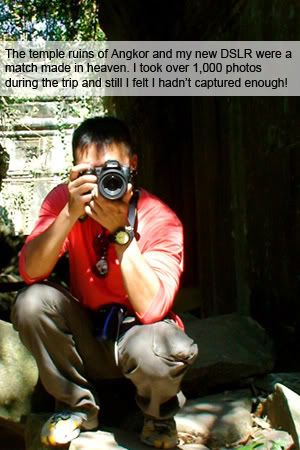 The two were a marriage made in heaven and I was on cloud nine the 5-days-4-nights I was there. In the 3 full days of playing Lara Croft, I visited 13 temple ruins of Angkor and took more than 1,000 photos! That place was so photogenic, my fingers went numb from all that trigger action. But clicking on the DSLR didn’t come naturally...
The two were a marriage made in heaven and I was on cloud nine the 5-days-4-nights I was there. In the 3 full days of playing Lara Croft, I visited 13 temple ruins of Angkor and took more than 1,000 photos! That place was so photogenic, my fingers went numb from all that trigger action. But clicking on the DSLR didn’t come naturally...
The first seven or eight photos I took at Angkor Wat were all black. I thought maybe it was due to the 5am sky which still hadn’t brighten up so I fiddled with the manual knobs and dials and shot a few more times… Still black. I wondered what’s wrong so I turned the camera around to check the lens.
I had forgotten to remove the lens cap.
What a duffer!! Thankfully the pre-dawn darkness shrouded my folly. But I still couldn't escape the constant ridicule by CW throughout the trip, and back.
I learnt how to use my Nikon D90 literally by asking other DSLR users on the streets. I’ve yet to master the camera so anyone who is willing to teach me manual photography, I’d be most happy to learn!
Travel Facts
Travel Period : 12 Dec 08 – 16 Dec 08
Currency : USD and Cambodian Riel (US$1.00 = S$1.51 = 4,000 riel)
Air Ticket : S$375.00 (SilkAir 2-way, exclude US$25 tax at Siem Reap on return flight)
Accommodations
Lotus Angkor Resort and Spa Hotel – US$50 per night
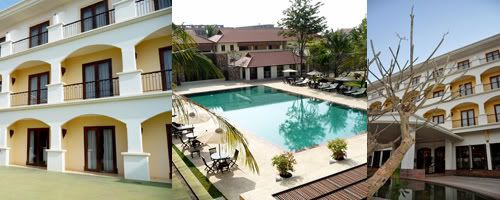
Nice and frills-free hotel with big rooms, soothing ambience and impeccable service. Stayed there for 2 nights and the hotel was about 10 mins by tuk tuk to the town centre, and 20 mins by car to Ang Kor Wat. My room had a door that opened out to a patio of sorts that overlooked the hotel's pool. Nice balcony for some drinks and stargazing.
Foreign Correspondents’ Club (FCC) Hotel – US$115 per night
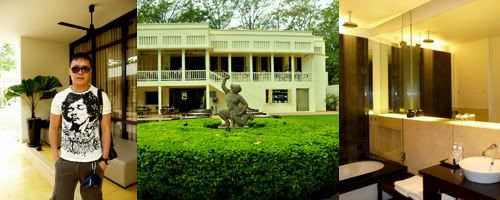
FCC is pretty small. It used to be the lodging for foreign correspondents previously before being converted into a hotel. For the room rate FCC commanded, I expected some 'wow' factor. Though the room was nice, well-decorated in a contemporary zen style with warm colors, there wasn't any special frills to value-add.
This is considered a 5-star hotel but it lacked the star quality of some other same ranked hotels where they provide fruit baskets or hi-fi system in the room. FCC did offer a free 15-min foot massage at their in-house spa but we didn't utilize it in case it was an opening to a sales pitch.
Angkor – Lego City
The temple ruins of Angkor are scattered around Siem Reap and there’re more than a thousand of them ranging from blocks of bricks in the farmland regions to the well-preserved 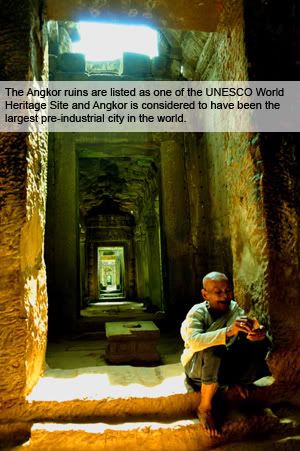 magnificence of Angkor Wat. From what I read, ‘Angkor’ basically defines a period of the Khmer empire in Cambodia from the 9th to the 15th century. During this period, the largely Hindu civilization built many temples under the self-declared ‘god-king’, Jayavarman II. The Angkorian period flourished till the time it was ravaged during the Siamese war and eventually losing its ground to the Thais in 1431 A.D. The Khmer people were forced to uproot to Phnom Penh.
magnificence of Angkor Wat. From what I read, ‘Angkor’ basically defines a period of the Khmer empire in Cambodia from the 9th to the 15th century. During this period, the largely Hindu civilization built many temples under the self-declared ‘god-king’, Jayavarman II. The Angkorian period flourished till the time it was ravaged during the Siamese war and eventually losing its ground to the Thais in 1431 A.D. The Khmer people were forced to uproot to Phnom Penh.
Angkor is derived from the Sanskrit word ‘nagara’ which means ‘city’. The rapid decline and abandonment of the Angkor temples attracted much scholarly debate but the theories seem to rest on the double whammy of war and an erosion of the state religion. What’s left today are the shells of glory past, a Lego playpen for the gods… but I hope they won’t re-stack the blocks because I met time amongst the artful decline.
Initially, I thought Angkor Wat was Siem Reap and Siem Reap was Angkor Wat. The enblem of the ancient temple is on the Cambodian national flag, their beer, and even cigarettes! But now I understood that there's more to Siem Reap than Angkor Wat. During the trip, I visited not just the world-famous monument, but discovered lesser known sights that may lack grandeur, but made up for in amazing stone craftsmanship. I kept wondering to myself, how did the ancient Khmer people do it? How did they move such massive pieces of rocks and stacked them in precision in the fields, deep inside the jungle, and on the mountains? How?
Passion can truly make a genius out of anyone.
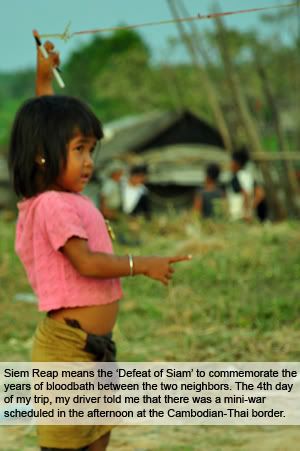 Throughout my stay there, I think the people of Siem Reap were friendly enough but I can’t help feeling that their hospitable smiles were because I’m a walking dollar note. Well, cash is king anywhere in the world, but in Siem Reap, the hoi polloi were really out to get it. Young children will follow you touting postcards, fridge magnets, flutes, handicrafts, drinks and knick-knack souvenirs while the adults call for you to buy t-shirts, eat, drink, buy bananas, pineapples, etc from as far as a hundred meters away! Perhaps it’s because the opportunity to earn the tourism dollar had a time-span.
Throughout my stay there, I think the people of Siem Reap were friendly enough but I can’t help feeling that their hospitable smiles were because I’m a walking dollar note. Well, cash is king anywhere in the world, but in Siem Reap, the hoi polloi were really out to get it. Young children will follow you touting postcards, fridge magnets, flutes, handicrafts, drinks and knick-knack souvenirs while the adults call for you to buy t-shirts, eat, drink, buy bananas, pineapples, etc from as far as a hundred meters away! Perhaps it’s because the opportunity to earn the tourism dollar had a time-span.
The best time to visit Siem Reap would be between November and February where it isn’t too hot to walk around. After that would be simply too dry and hot and by July or so, the rain will make visiting the largely outdoor archaeological sites impossible if not by turning the dirt roads muddy, then the steep steps leading up the temples will be rendered too slippery. The ancient people of Siem Reap must have really small feet because the width of most stairways at the temples can barely hold half my feet, and I’m only a US size 8.
To visit the temples, you need to get an entry pass and there’re wardens that will check it. A fine is levied on those caught on the temple grounds without a pass. I can’t remember how much was the single-day pass, but the 3-day pass cost US$40. This pass allowed us unlimited visits to Angkor Wat, Bayon, Banteay Srei, Ta Prohm, etc.
Angkor Wat – Rated BBB (Big But Boring)
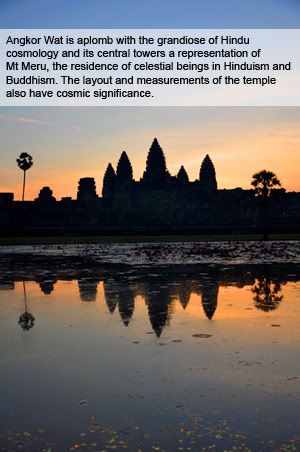 Don’t get me wrong. Angkor Wat is breathtaking in its own right. We opted to catch the sunrise over Angkor Wat so we arrived while the moon still held the sky’s black cloak as its only incandescent button. I crept onto the long bridge leading to the temple with a small torch light as my guide. I could make out the size of the architectural relic, but not its beauty. However, when I left the temple in broad daylight, I turned back while on the same long bridge and imagined what I would’ve felt if this was the first sight of Angkor Wat that greeted me. I would’ve been awed.
Don’t get me wrong. Angkor Wat is breathtaking in its own right. We opted to catch the sunrise over Angkor Wat so we arrived while the moon still held the sky’s black cloak as its only incandescent button. I crept onto the long bridge leading to the temple with a small torch light as my guide. I could make out the size of the architectural relic, but not its beauty. However, when I left the temple in broad daylight, I turned back while on the same long bridge and imagined what I would’ve felt if this was the first sight of Angkor Wat that greeted me. I would’ve been awed.
I guess the first encounter with Angkor Wat would be most memorable because once inside, it’s just a lot of grassy plot dotted with some stone buildings here and there. My dismay could also be due to the restoration work that was going on during my visit – the middle dome had scaffolding built on its side that spoilt the overall aesthetics (I had to Photoshop the ladders out). Apart from that, quite a few areas in the central compound were cordoned off and we couldn't climb up the central towers.
The walls of Angkor Wat are decorated with lots of carvings of asparas (celestial maidens), devatas (guardian gods), devas (gods), and asuras (demons). The most famous bas-relief would be that of the Churning of the Sea of Milk, but too bad I didn't see it. Or maybe I did but didn't recognise from that whole clustter of carvings alongside a corridor that seemed to stretch forever. Angkor Wat impresses by sheer size but after one too many dancing asparas, my interest in them expired. And that place reeked of dank horse piss. The phrase, ‘stinking treasure’ comes to mind.
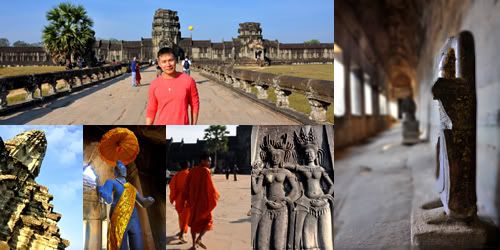
Beng Mealea – All Ba(e)nged Out
 Of all the temples and sights we’d seen in Siem Reap, Beng Mealea would have to be the weakest link. For one, the ruins were located about an hour’s drive from Angkor Wat and we had to pay additional admission fee to see it. Secondly, the ruins were nothing spectacular and we literally had to climb the collapsed wall to see one part of it. The good thing about Beng Mealea was that there aren’t many tourists around but then again, the problem with our tourists is that you want them out of your picture, and at Beng Mealea, there wasn’t much to photograph in the first place.
Of all the temples and sights we’d seen in Siem Reap, Beng Mealea would have to be the weakest link. For one, the ruins were located about an hour’s drive from Angkor Wat and we had to pay additional admission fee to see it. Secondly, the ruins were nothing spectacular and we literally had to climb the collapsed wall to see one part of it. The good thing about Beng Mealea was that there aren’t many tourists around but then again, the problem with our tourists is that you want them out of your picture, and at Beng Mealea, there wasn’t much to photograph in the first place.
So if you plan to visit this place, see it early in your itinerary before you get majorly disappointed after seeing all the other temples. Beng Mealea was the second temple we saw so the enthusiasm was still fresh and the magic of seeing extensive roots systems tearing apart yet holding the temple walls together held me spellbound. Ben Mealea was considered one of the rare jungle temples and wasn’t easily accessible until rather recently. It was modeled after Angkor Wat so there was much masonry mirrored from the state icon. Probably the most memorable sight here would be the lotus filled moat that greeted us at the entrance.
We were also misled to explore the temple from the left by a ‘guide’ who pointed us the way without us soliciting for his ‘services’. These unofficial guides are plenty, especially at the less popular temples. These guides weren’t exactly fluent in English and they don’t tell you the history and stuff but just merely point to something and name them… “Hello, statue.” “Hello, carving.” “Hello, library.” “Hello, tree.” Hello, I know what they are and I can see them myself. Generally, they would ask for some money at the end of the ‘tour’. I you don’t wan them to follow you around pointing out the obvious, just politely say that you would like to see the temple alone. When facing the ruins of Beng Mealea, start from your right rather than go left.
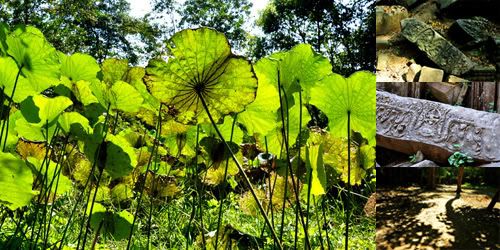
Banteay Srei - Crown Ruby of Khmer Art
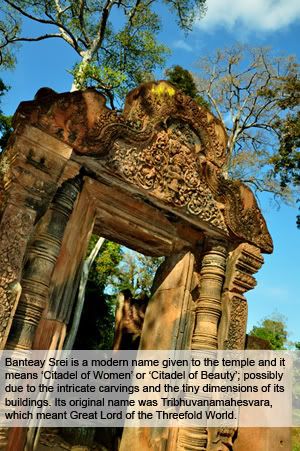 The entrance to Banteay Srei didn't seem like much. While walking up to what's left of the entrance, I thought the site was just going to be some wildly strewn red rocks peaking out from the ground and that place don't even have a roof above it. But on closer examination, the 'door' frame was intricately carved and the pertruding patterns made more vivid from the shadows cast by the afternoon sun.
The entrance to Banteay Srei didn't seem like much. While walking up to what's left of the entrance, I thought the site was just going to be some wildly strewn red rocks peaking out from the ground and that place don't even have a roof above it. But on closer examination, the 'door' frame was intricately carved and the pertruding patterns made more vivid from the shadows cast by the afternoon sun.
One thing rather peculiar about this temple was that the doorways were all pretty short and narrow. I could see that some heavyset Caucasian tourists avoided going through them for fear that they may be stuck? That would be funny. But the buildings in this temple were really puny in proportions. It was unusual. Its petite stature made its highly decorated pillars and walls looked even more delicate... like a red rosebud thrown to the winds.
Once past the walkway, I was greeted by a few stupas hurdled closely together. With their pointed roofs and compact size, they reminded me of chimneys, those that sit on top cremation chambers. Amongst the midget towers sat four stone statues of what looked like monkey and lion heads on human bodies. I think they're guardian gods but it's interesting that one monkey-monkey set guards one entrance, while the other lion-lion pair guards another. Are they different gods or are the monkey-looking ones representing the good, while the fiercer lion ones the evil? Anyhow, they looked like they were waiting to play mahjong.
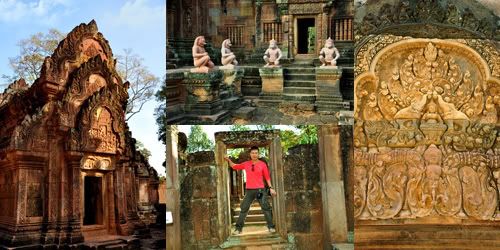
Pre Rup - Rubbed And Rubbed, But No Magic
 Pre Rup means ‘Turning the Body’ and it originates from the belief by the Cambodian people that this temple was used as a crematorium. Now, it is used by tourists to roast in the dusking sun for it is reputed as the best place to catch the sunset. But frankly, there’s nothing impressive about it.
Pre Rup means ‘Turning the Body’ and it originates from the belief by the Cambodian people that this temple was used as a crematorium. Now, it is used by tourists to roast in the dusking sun for it is reputed as the best place to catch the sunset. But frankly, there’s nothing impressive about it.
It was supposed to be beautiful with padi fields stretching to meet a silhouetted forest against the glowing pastel sky. But well, the padi fields were a flat green so there was no depth to the scenery. And the setting sun hid behind a tree on its way down, which had a picturesque effect, but a minute of it and a few photos were enough to sum up the moment. As it set any lower, the amber disc got blocked by the terrain of blackened canopies.
We arrived at about five plus to anticipate the sunset and it didn’t happen till half past six, so there was quite a bit of waiting. And the wait seemed long because Pre Rup was rather dull on the irises. Whatever little carvings or bas relief the temple had were eroded and smoothened out so it was basically a walled labyrinth of red bricks and collapsed towers. I tried to believe that the sunset was spectacular and magical, but no matter how much I rubbed my Nikon, the pictures don’t lie. There wasn’t much to create even the slightest hocus pocus about Pre Rup or its famed sunset.
To get a really nice shot of the sunset, station yourself towards the west early and stay there. Once you move, tourists will fill in and you get photographic homicide with pesky heads and worse, big floppy hats of Japanese ladies.
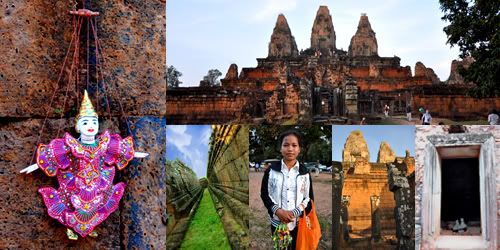
Bayon - Face Off With Time
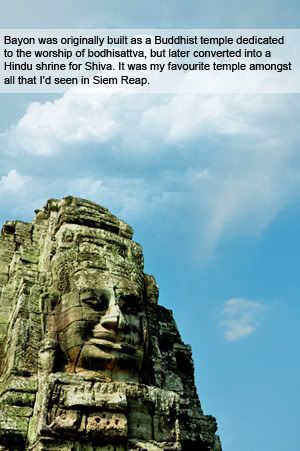 My third day in Siem Reap was greeted in the morning by the smiling faces at the Bayon temple. There’s a sort of unsettling calm about this place… on the one hand, the serenity caught on stone exudes a timelessness that neutralises the fear of mortality; but on the other, the crowding of 216 faces on 54 gothic towers in such a small area breeds claustrophobia. This place soothed and flustered me at the same time.
My third day in Siem Reap was greeted in the morning by the smiling faces at the Bayon temple. There’s a sort of unsettling calm about this place… on the one hand, the serenity caught on stone exudes a timelessness that neutralises the fear of mortality; but on the other, the crowding of 216 faces on 54 gothic towers in such a small area breeds claustrophobia. This place soothed and flustered me at the same time.
From afar, the Bayon looked like a pyramidal dump of dull grey rocks. But as I got closer, the magic of its postcard faces start to cast their spells. This ruin is beautiful. In retrospect, it was my favorite amongst all the temples I’d seen during the trip, except for those ‘death’ steps leading to where the faces were. I wondered if it was the effect of erosion or were the steps cut really narrow by the ancient builders on purpose. Unless your feet are those of caterpillar’s, you have to climb on fours to go up or down the stairs. And the added treachery was dangling a heavy DSLR around my neck.
Bayon is situated right in the middle of Angkor Thom, an ancient city built during the reign of King Jayavarman VII (1181 – 1219). Not too far from Angkor Wat, Angkor Thom is an archaeological banquet with many ancient ruins to dig into. Apart from Bayon, there are the ruins of Baphuon, the Elephant Terrace, Victory Gates, etc, all within walking distance of one another. But Bayon is still the most enigmatic.
For one, no researcher can be sure if the faces represented that of Jayavarman or Buddha. Secondly, it’s puzzling why its internal chambers are so damn cramped. And lastly, how did I manage to take close to 100 shots of just one place?! Patience is much needed in photographing Bayon because it teems with tourists and you have to wait a long time for those Chinese (or Taiwanese?) aunties to take the same spot in 20 different poses, one after the other!
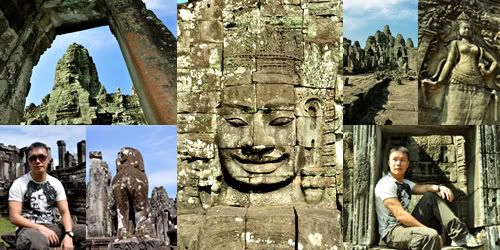
Ta Prohm – Man vs. Nature Tug-of-War
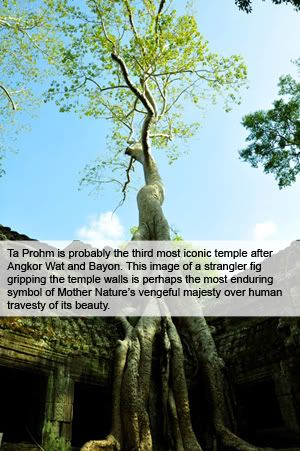 Here sits another of nature’s trophies on man’s creation. But unlike the swift catastrophe of destructive weathers, this tug-of-war between nature and man emanates a sort of eerie allure that enthralls. This temple-ruin is made beautiful by that which is destroying it. Herein lies the irony of Ta Prohm.
Here sits another of nature’s trophies on man’s creation. But unlike the swift catastrophe of destructive weathers, this tug-of-war between nature and man emanates a sort of eerie allure that enthralls. This temple-ruin is made beautiful by that which is destroying it. Herein lies the irony of Ta Prohm.
"Everywhere around you, you see nature in this dual role of destroyer and consoler; strangling on the one hand, and healing on the other; no sooner splitting the carved stones asunder than she dresses their wounds with cool, velvety mosses, and binds them with her most delicate tendrils; a conflict of moods so contradictory and feminine as to prove once more if proof were needed how well ‘Dame’ Nature merits her feminine title." (Excerpt from Tourism Cambodia on Ta Prohm)
When explorers first discovered the temple, it was practically swallowed by the jungle. Today, much of that jungle had been ‘manicured’, leaving only enough vegetation in, and on the temple for atmospheric effects. Ta Prohm is easy on the camera but the lighting can be a challenge because of inconsistent shadows cast by an abundance in foliage. And again, the challenge is in waiting for people to clear the scene for a nice clean shot. But people are not the only spoilers. There is a wooden platform and are some barricades set up at the base of the strangler fig spot and those are the real photo killers.
Ta Prohm is pretty big and with all the cascading roots and unearthed rocks, it is possible to get a little lost here. Moreover, some of the doorways lead to blocked recesses or collapsed chambers with no way out. I was exploring the ruins when I wormed my way into a hallway of sorts partially sealed off by fallen stone beams. Despite the overpowering smell of ammonia, I thought about how nice it would be to be locked in embrace with a love one in this little sanctuary, a private space with sunlight filtering through the leaves, a quiet spot filled with epoch artistry of eons past, just the two of us.
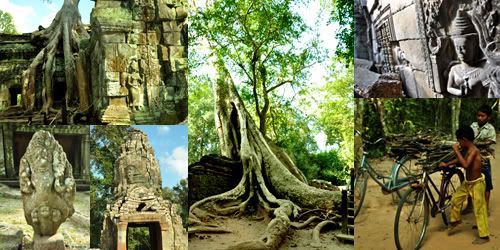
Ta Keo – A Woman Without Make-Up
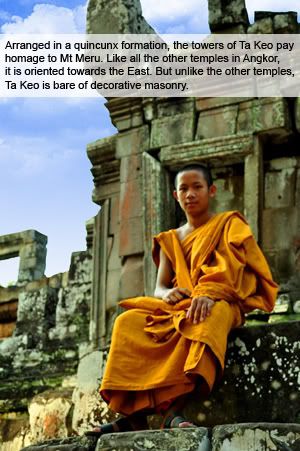 According to records, one of the towers of Ta Keo was struck by lightning half-way through its construction. Taking that as a bad omen, building works stopped and the temple was never completed. But there’re other theories about its abandonment. Some said it was never completed because of the death of its patron king, Jayavarman V, while others claimed dissertation due to the fact that the high-quality sandstone used to build this temple was too hard to carve.
According to records, one of the towers of Ta Keo was struck by lightning half-way through its construction. Taking that as a bad omen, building works stopped and the temple was never completed. But there’re other theories about its abandonment. Some said it was never completed because of the death of its patron king, Jayavarman V, while others claimed dissertation due to the fact that the high-quality sandstone used to build this temple was too hard to carve.
Today, its bare walls provided a glimpse of the basic structure and foundation of temples in Angkor. Without the decorative carvings and stories on the walls, Ta Keo looks great from far, but far from good up-close. Had it been completed, I think it would rival the magnetism of Banteay Srei.
I met some local children here and there’re very wallet-enthusiastic. They shared with me that they attend school in the morning and come to the temple grounds to peddle souvenirs or be unofficial guides to get some income. I didn’t buy any of the souvenirs, but I did tip a teenager (about 14?) for pointing out things that I could see and already known. Well, hopefully that would be encouragement for him to learn more English so that he could be a proper guide that shares useful knowledge rather than merely pointing out the obvious. But this guy had a unique skill. He could scale the narrow steps leading to the stupas in seconds! While I almost went on fours to climb, he was skipping up the stairs like a grasshopper.
Ta Keo is not a must-see but since it is not too far from Ta Prohm, seeing more of Siem Reap is better than less although there isn’t much retinal literacy here.
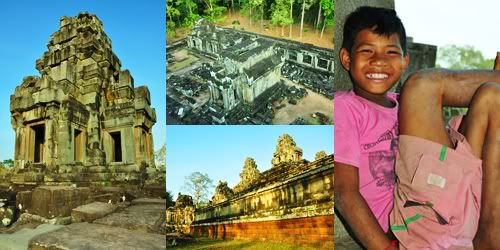










 The two were a marriage made in heaven and I was on cloud nine the 5-days-4-nights I was there. In the 3 full days of playing Lara Croft, I visited 13 temple ruins of Angkor and took more than 1,000 photos! That place was so photogenic, my fingers went numb from all that trigger action. But clicking on the DSLR didn’t come naturally...
The two were a marriage made in heaven and I was on cloud nine the 5-days-4-nights I was there. In the 3 full days of playing Lara Croft, I visited 13 temple ruins of Angkor and took more than 1,000 photos! That place was so photogenic, my fingers went numb from all that trigger action. But clicking on the DSLR didn’t come naturally... 

 magnificence of Angkor Wat. From what I read, ‘Angkor’ basically defines a period of the Khmer empire in Cambodia from the 9th to the 15th century. During this period, the largely Hindu civilization built many temples under the self-declared ‘god-king’, Jayavarman II. The Angkorian period flourished till the time it was ravaged during the Siamese war and eventually losing its ground to the Thais in 1431 A.D. The Khmer people were forced to uproot to Phnom Penh.
magnificence of Angkor Wat. From what I read, ‘Angkor’ basically defines a period of the Khmer empire in Cambodia from the 9th to the 15th century. During this period, the largely Hindu civilization built many temples under the self-declared ‘god-king’, Jayavarman II. The Angkorian period flourished till the time it was ravaged during the Siamese war and eventually losing its ground to the Thais in 1431 A.D. The Khmer people were forced to uproot to Phnom Penh. Throughout my stay there, I think the people of Siem Reap were friendly enough but I can’t help feeling that their hospitable smiles were because I’m a walking dollar note. Well, cash is king anywhere in the world, but in Siem Reap, the hoi polloi were really out to get it. Young children will follow you touting postcards, fridge magnets, flutes, handicrafts, drinks and knick-knack souvenirs while the adults call for you to buy t-shirts, eat, drink, buy bananas, pineapples, etc from as far as a hundred meters away! Perhaps it’s because the opportunity to earn the tourism dollar had a time-span.
Throughout my stay there, I think the people of Siem Reap were friendly enough but I can’t help feeling that their hospitable smiles were because I’m a walking dollar note. Well, cash is king anywhere in the world, but in Siem Reap, the hoi polloi were really out to get it. Young children will follow you touting postcards, fridge magnets, flutes, handicrafts, drinks and knick-knack souvenirs while the adults call for you to buy t-shirts, eat, drink, buy bananas, pineapples, etc from as far as a hundred meters away! Perhaps it’s because the opportunity to earn the tourism dollar had a time-span.  Don’t get me wrong. Angkor Wat is breathtaking in its own right. We opted to catch the sunrise over Angkor Wat so we arrived while the moon still held the sky’s black cloak as its only incandescent button. I crept onto the long bridge leading to the temple with a small torch light as my guide. I could make out the size of the architectural relic, but not its beauty. However, when I left the temple in broad daylight, I turned back while on the same long bridge and imagined what I would’ve felt if this was the first sight of Angkor Wat that greeted me. I would’ve been awed.
Don’t get me wrong. Angkor Wat is breathtaking in its own right. We opted to catch the sunrise over Angkor Wat so we arrived while the moon still held the sky’s black cloak as its only incandescent button. I crept onto the long bridge leading to the temple with a small torch light as my guide. I could make out the size of the architectural relic, but not its beauty. However, when I left the temple in broad daylight, I turned back while on the same long bridge and imagined what I would’ve felt if this was the first sight of Angkor Wat that greeted me. I would’ve been awed.
 Of all the temples and sights we’d seen in Siem Reap, Beng Mealea would have to be the weakest link. For one, the ruins were located about an hour’s drive from Angkor Wat and we had to pay additional admission fee to see it. Secondly, the ruins were nothing spectacular and we literally had to climb the collapsed wall to see one part of it. The good thing about Beng Mealea was that there aren’t many tourists around but then again, the problem with our tourists is that you want them out of your picture, and at Beng Mealea, there wasn’t much to photograph in the first place.
Of all the temples and sights we’d seen in Siem Reap, Beng Mealea would have to be the weakest link. For one, the ruins were located about an hour’s drive from Angkor Wat and we had to pay additional admission fee to see it. Secondly, the ruins were nothing spectacular and we literally had to climb the collapsed wall to see one part of it. The good thing about Beng Mealea was that there aren’t many tourists around but then again, the problem with our tourists is that you want them out of your picture, and at Beng Mealea, there wasn’t much to photograph in the first place.
 The entrance to Banteay Srei didn't seem like much. While walking up to what's left of the entrance, I thought the site was just going to be some wildly strewn red rocks peaking out from the ground and that place don't even have a roof above it. But on closer examination, the 'door' frame was intricately carved and the pertruding patterns made more vivid from the shadows cast by the afternoon sun.
The entrance to Banteay Srei didn't seem like much. While walking up to what's left of the entrance, I thought the site was just going to be some wildly strewn red rocks peaking out from the ground and that place don't even have a roof above it. But on closer examination, the 'door' frame was intricately carved and the pertruding patterns made more vivid from the shadows cast by the afternoon sun.
 Pre Rup means ‘Turning the Body’ and it originates from the belief by the Cambodian people that this temple was used as a crematorium. Now, it is used by tourists to roast in the dusking sun for it is reputed as the best place to catch the sunset. But frankly, there’s nothing impressive about it.
Pre Rup means ‘Turning the Body’ and it originates from the belief by the Cambodian people that this temple was used as a crematorium. Now, it is used by tourists to roast in the dusking sun for it is reputed as the best place to catch the sunset. But frankly, there’s nothing impressive about it.
 My third day in Siem Reap was greeted in the morning by the smiling faces at the Bayon temple. There’s a sort of unsettling calm about this place… on the one hand, the serenity caught on stone exudes a timelessness that neutralises the fear of mortality; but on the other, the crowding of 216 faces on 54 gothic towers in such a small area breeds claustrophobia. This place soothed and flustered me at the same time.
My third day in Siem Reap was greeted in the morning by the smiling faces at the Bayon temple. There’s a sort of unsettling calm about this place… on the one hand, the serenity caught on stone exudes a timelessness that neutralises the fear of mortality; but on the other, the crowding of 216 faces on 54 gothic towers in such a small area breeds claustrophobia. This place soothed and flustered me at the same time.
 Here sits another of nature’s trophies on man’s creation. But unlike the swift catastrophe of destructive weathers, this tug-of-war between nature and man emanates a sort of eerie allure that enthralls. This temple-ruin is made beautiful by that which is destroying it. Herein lies the irony of Ta Prohm.
Here sits another of nature’s trophies on man’s creation. But unlike the swift catastrophe of destructive weathers, this tug-of-war between nature and man emanates a sort of eerie allure that enthralls. This temple-ruin is made beautiful by that which is destroying it. Herein lies the irony of Ta Prohm.
 According to records, one of the towers of Ta Keo was struck by lightning half-way through its construction. Taking that as a bad omen, building works stopped and the temple was never completed. But there’re other theories about its abandonment. Some said it was never completed because of the death of its patron king, Jayavarman V, while others claimed dissertation due to the fact that the high-quality sandstone used to build this temple was too hard to carve.
According to records, one of the towers of Ta Keo was struck by lightning half-way through its construction. Taking that as a bad omen, building works stopped and the temple was never completed. But there’re other theories about its abandonment. Some said it was never completed because of the death of its patron king, Jayavarman V, while others claimed dissertation due to the fact that the high-quality sandstone used to build this temple was too hard to carve. 